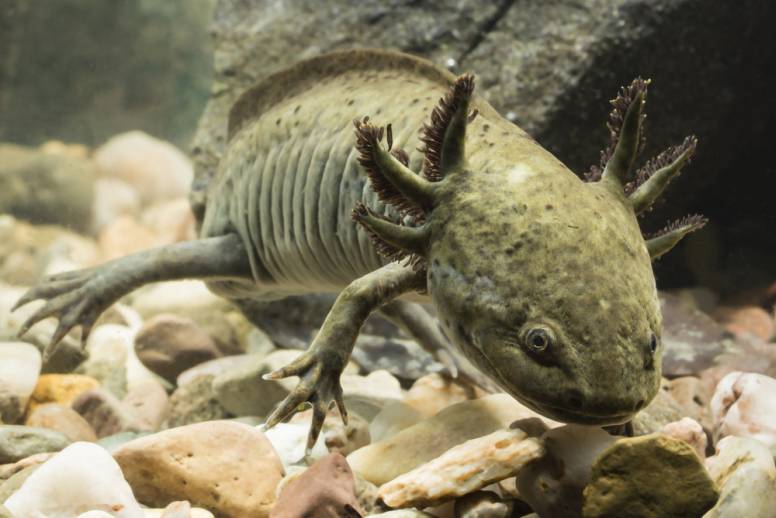Hello ladies and gents this is the viking telling you that today we are talking about
Axolotl Profile

The Axolotl is a neotenic salamander and is considered to be one of the world’s most unusual and unique species of salamanders. The ‘Mexican Walking Fish’ as it is commonly referred to, isn’t actually a fish – it’s an amphibian. Axolotl can be found in Mexico in freshwater lakes and ponds.
Axolotl Facts Overview
- Habitat: Freshwater lakes & ponds
- Location: Mexico
- Lifespan: 10 – 15 Years
- Size: 15 – 45 cm (6 – 18 inches)
- Weight: 2 – 8 ounces (0.06 – 0.1 Kg)
- Color: White, pink & dark brown
- Diet: Worms, tadpoles, insects, small fish
- Predators: Birds (storks & herons) & other large fish
- Top Speed: 15 kph (10 mph)
- Conservation Status: Critically Endangered
What makes this such an unusual amphibian is how it reaches adulthood. It does not undergo metamorphosis (the process in which they develop lungs and legs and take to land) that typically occurs in amphibians. The Axototl retains the characteristics it develops at the larval stage, keeping its gills and retaining an aquatic life.
The Axolotl measures between 15-45 centimetres in length at the adult stage. They will weigh about 0.06 to 0.1 kilogram, but can reach 0.5 kilograms in captivity.
They feed generally on smaller species of aquatic life mostly focusing on tiny fish, mollusks and arthropods. Their diet can vary to include additional fresh water creatures such as terrestrial worms, salmon eggs and zooplankton.
The Axolotl is classified as a critically endangered species. In fact, it is almost extinct due to invasive species being introduced into its habitat, as well as habitat loss.
Interesting Axolotl Facts
1. Axolotl have an astonishing ability to regenerate body organs and lost limbs.
Incredibly, an Axolotl can grow back lost limbs in only a few weeks. It can even regenerate its lungs, heart, spinal cord and parts of its brain, if it suffers a head injury and heals without any scarring. A study by the University of Minnesota found that a protein called c-Fos is crucial for the regeneration process. Professor Stephane Roy of University of Montreal explained to Scientific American:
You can cut the spinal cord, crush it, remove a segment, and it will regenerate. You can cut the limbs at any level—the wrist, the elbow, the upper arm—and it will regenerate, and it’s perfect. There is nothing missing, there’s no scarring on the skin at the site of amputation, every tissue is replaced. They can regenerate the same limb 50, 60, 100 times. And every time: perfect and please dont
2. Axolotl can regrow the same limb up to 5 times. Then it stops.
There appears to be a limit of how many times the Axolotl is capable of regrowing a limb. Scientists discovered that by the fifth time, few limbs could regrow to their previous potential and instead, scar tissue started to form.
3. The feathery looking branches that extend from either side of its head are its gills.
Axolotl retain their gills, but also have lungs that are fully functional. They will often rise to the surface for a gulp of air.
4. The Axolotl is also over 1,000 times more resistant to cancer than mammals.
Scientists hope that we can one day harness the axolotls natural resistance to eliminate cancer and extend our lifespans.
5. Axolotl are only be found in Mexico.
Their natural habitat is Lake Xochimilco, an ancient network of lakes and canals in southern Mexico City. Although they also survive in aquariums, water tanks and research labs around the world.
and always have a chilled day from the Viking
Comments
Post a Comment